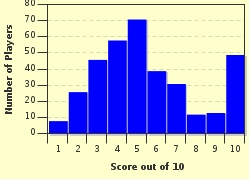Quiz Answer Key and Fun Facts
1. Starting at the beginning, what is the translation of the Sanskrit term 'advaita'?
2. My screen name is satguru, from Sanskrit. What is the direct meaning in English?
3. An essential part of learning is satsang. How does this translate to English?
4. Another method towards enlightenment is the transfer of energy from the master to the student. What is the usual term for this method?
5. What is the predominant practice used by students of advaita towards enlightenment?
6. Is enlightenment the end of the advaita path?
7. The essence of advaita teaching is that duality (ie that there is you and everything else) is an illusion. What Sanskrit word is used for this illusion?
8. Only one thing is constant in advaita, consciousness. What term is given to the apparent activity within it which changes constantly?
9. What would you do in darshan?
10. The enlightened person is in constant bliss.
Source: Author
satguru
This quiz was reviewed by FunTrivia editor
agony before going online.
Any errors found in FunTrivia content are routinely corrected through our feedback system.

